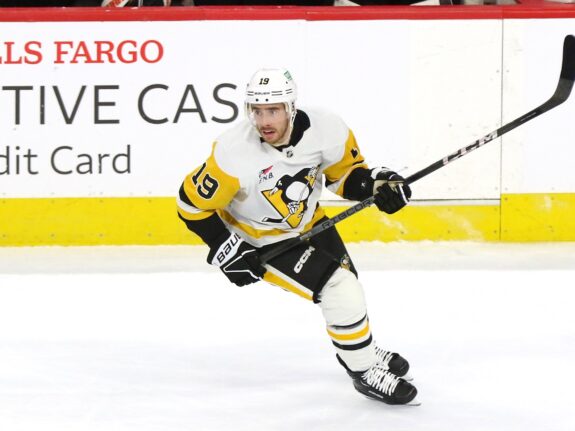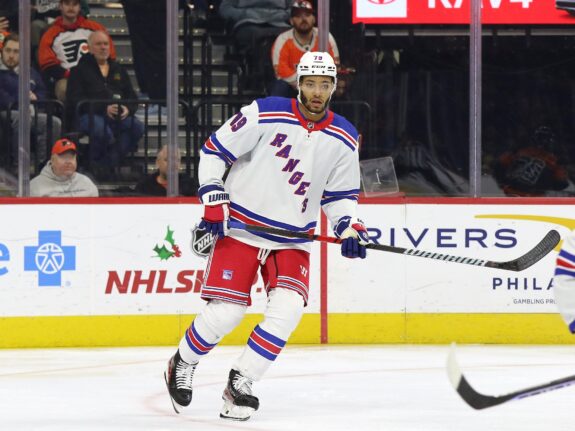While five-on-five play has underperformed over the past few seasons, the New York Rangers have been wildly successful on the power play. Since the 2020-21 season, the Rangers rank fourth in the NHL on the power play at 24.3%. A large part of their two Eastern Conference Final runs in the past three seasons has been a credit to their special teams’ play.
Over that same span, the Rangers have a 26.1% success rate on the man advantage in the postseason, good for fifth in the NHL. Yet, as large a part as the power play has played in their long runs when it fizzles out, so does their season.
When the Rangers entered the Eastern Conference Final against the Florida Panthers, their power play was 11-for-35 (31.4%). During the six-game series, they went 1-for-15 (6.66%) en route to their Stanley Cup hopes being squashed. The man advantage was not the only reason the Blueshirts fell to the Panthers, but for the second time in three postseasons, we were left wondering what a little tinkering to the units during their struggles would have done to get them going.
It’s hard to look at a successful power play and say that changes are needed. However, the Rangers are in a unique situation with loads of offensive talent and players who deserve opportunities that have not yet been given to them. Except for Filip Chytil swapping in for Jonny Brodzinski when he returned from his injury, the two power-play units looked like this:
- First Unit: Adam Fox, Mika Zibanejad, Artemi Panarin, Chris Kreider, Vincent Trocheck
- Second Unit: Filip Chytil/Jonny Brodzinski, Erik Gustafsson, Kaapo Kakko, Alexis Lafreniere, Jack Roslovic
Heading into 2024-25, it may be time to consider balancing these units further.
Proposed Personnel Changes to the Power-Play Units
The Rangers have had a top-heavy power play in the past three seasons. Their first unit saw the bulk of the ice time, which led to the bulk of the production. The star-studded unit has developed serious chemistry, with Trocheck slotting into the bumper position seamlessly.
It is hard to change a balanced unit. Still, the disparity between the first unit’s production and the second unit’s ability to score is an issue that has a relatively simple fix.
On the second power play is Lafreniere, who, after a career year in 2023-24, has earned a look on the top unit. His play alongside Panarin and Trocheck would translate well to the man advantage, and his ability to carry the puck into the zone will serve as additional zone entry support for Panarin.
It makes sense to place him on the right side, allowing Panarin to shift to his off-wing on the left. This will give the Rangers two off-wing one-timer options and two sticks in position to feed passes through the seams. The corresponding move would be to relegate Zibanejad to the second unit.
Related: 4 New York Rangers Storylines to Follow in 2024-25
While this may seem like a demotion, the second unit desperately needs more in-zone shot options. With Chytil in the bumper spot and newly acquired Reilly Smith on the right side, adding Zibanejad to the left would create a trio of shot options this unit has desperately craved.

Kakko, who likes to shield the puck, could be the net-front presence, while Zac Jones or K’Andre Miller runs the blue line. This creates symmetry amongst the two units and will allow Peter Laviolette to rotate through them freely, going with the hot hand approach rather than letting the first unit play out their struggles.
Plus, the added flexibility that a willingness to move pieces around will give could prove to limit droughts come the postseason. Zibanejad could quickly jump back onto the first unit should there be struggles, and other forwards can also rotate between the two special teams units.
Change the Quarterback on Power Play Two
As alluded to earlier, Gustafsson was the primary quarterback for the second unit. When he was absent, Jacob Trouba stepped into the role. With Gustafsson signing in Detroit and Trouba struggling last season, the Rangers should allow Jones or Miller to take the reins.
Miller had 30 points last season after setting a career high with 43 in 2022-23. He has shown flashes of offensive brilliance and would undoubtedly provide a spark to the second power play.
Jones had nine points over 31 games with the Rangers last season. Coming out of the University of Massachusetts, his offensive upside drew the Rangers to him. His vision with the puck and ability to find shooting lanes make him a prototypical power-play quarterback. Similarly to Gustafsson, he has excellent offensive instincts and could find a home on the man advantage.
At this stage, Trouba should not be blocking Miller or Jones from jumping onto the second power-play unit. Both players are more dynamic with the puck, replacing Trouba’s shoot-first approach with a dual threat of passing and shooting. Miller and Jones exemplified their puck possession skills, a focal point of playing on the blue line of the power play.
Additionally, the younger defensemen possess better foot speed than Trouba, allowing them to respond quickly to potential turnovers. It is time for the younger defensemen to have an opportunity to quarterback the power play, and Miller or Jones are poised to do it.

Revamped units on the power play are not at the forefront of changes the Rangers must implement this season. But spicing things up and breaking free from the monotony of the five-man groupings could allow for a more dynamic performance all-around as opposed to the top-heavy approach they have featured the past three seasons.
